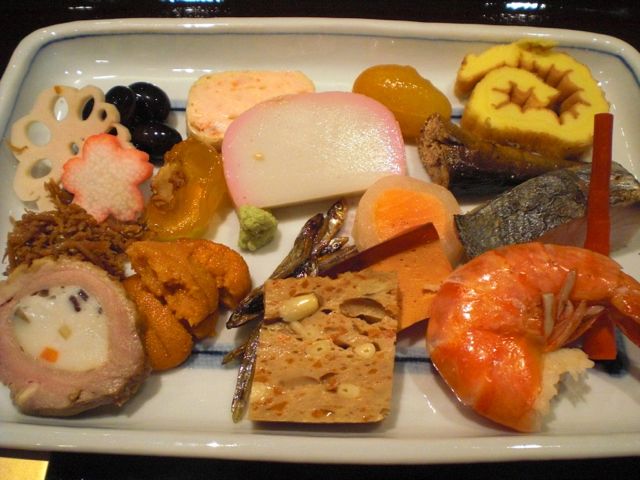New Years day was very mild and quiet. After having
cafe latte to wake up, we had a customary new year's soup or "
ozouni" お雑煮 which is the same as any other year. Many variations of ozouni by regions and families exist. If you are interested, here is
the pictures of all kinds of ozouni across Japan.
When I've made excuses 3 years running for not making osechi おせち料理 juubako 重箱 (layered boxes, with three layers being the full implementation), nobody will believe that I used to make 3 layer boxes every year for many years. In any case, I have an excuse again this year and only made a few dishes for the new year.
Salmon kelp roll (left upper) and Japanese style chicken loaf with pine nuts (right upper) were specifically requested by my wife. This year, I made matsumae-zuke 松前漬け. The Japanese chicken loaf is called "pine breeze grill" or
matsukaze-yaki 松風焼き.

Matsumaezuke was made from a "kit" which contained thinly cut threads of dried kelp and squid. I added a mixture of broth (from dashi pack), soy sauce and mirin (1:1:1 ratio) and let them sit in a refrigerator overnight. I prepared herring roe or
kazoko 数の子 as before. Since this was a New Year deluxe version, I cut up the kazunoko in large chunks and mixed in.
For chicken Matsukaze-yaki, I cleaned and hand chopped chicken thighs into ground chicken (about 1 lb). I mixed in miso (2-3 tsp), sugar (1-2 tsp), mirin (1 tsp), flour (2-3 tsp), soy sauce (2 tsp), egg (one beaten), panko (about 1/2 cup) and mixed well (of course,you could use a food processor but I did it all by hand since I did not want to clean the bowl of the food processor). My wife helped me by dry-roasting pine nuts (3 tbs). After the pine nuts cooled down, I mixed the nuts into the meat mixture. I sprayed
Pam on the metal baking dish (about 5x7 inches) and placed a parchment paper on the bottom. I then spread the mixture into the pan with a spatula to slightly less than 1/2 inch thick loaf. I baked it in a 350F preheated oven for 20-25 minutes or until the meat mixture pulled away from the sides of the pan.
After it cooled, I removed the loaf from the baking dish. Because of the Pam spray and the parchment paper, it came out without any difficulty. I first removed the all four edges (good snacking) and cut it in half dividing the short side into two long rectangles. I then cut the pieces into the shape of a Japanese "
Hagoita" 羽子板 racket like you see here on the left. "Hagoita" is a racket used in a Japanese girl's New Year game called "Hanetsuki" 羽根つき which is something like badminton but the racket is made entirely of wood. Nobody plays this game and "Hagoita" has been transformed into a New Year's decorative item rather than actually being used as a racket. In any case, the shape of this dish is to imitate "hagoita". Just before serving, I inserted the toothpick in the narrowest end to further emulate the handle of the hagoita. I brushed a bit of mirin on one side and coated it with aonori 青海苔 or powdered green sea weed (see the second picture from the top). Between the pine nuts and the green color, the New Years theme "pine breeze" is complete. Pine is auspicious along with bamboo and plum flower or "shou-chiku-bai" 松竹梅 in Japanese culture especially in New Year.
But this is not the exciting part of new year's dishes. We got special osechi dishes this year from
Sushi Taro 寿司太郎. This is the first year we learned that Sushi Taro makes New Year's Osechi layered boxes or Juubako, without hesitation, we signed up to get it.
We drove to Dupont Circle on December 31 to pick it up. This is a two tired juubako wrapped in furoshiki 風呂敷, a Japanese wrapping cloth. It felt very heavy (a good sign!). According to my wife, who ran into the restaurant, while I waited outside double parked, the dining area of the restaurant had been converted to assembly area for osechi juubako.
After we came home, we unwrapped the furoshiki revealing the menu written in Japanese and English. Expectation heightened while we waited until New Year's day evening to fully enjoy this (come back for the next installment to see what surprises await--to be continued).
 Everything was very good. Many of the items can only be made by a professional chef; for example, the monkfish liver terrine 鮟肝豆腐--which was exquisite. The fish especially the sweet fish or "ayu" with roe 子持ち鮎 was a stand out. With something like this available, I have the perfect excuse for not making Osechi myself.
Everything was very good. Many of the items can only be made by a professional chef; for example, the monkfish liver terrine 鮟肝豆腐--which was exquisite. The fish especially the sweet fish or "ayu" with roe 子持ち鮎 was a stand out. With something like this available, I have the perfect excuse for not making Osechi myself.
